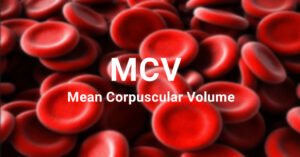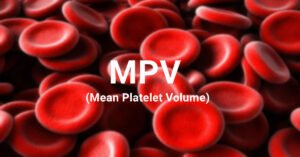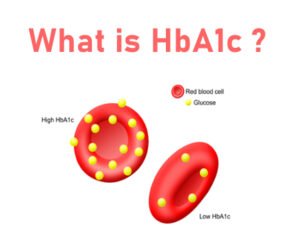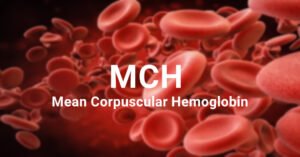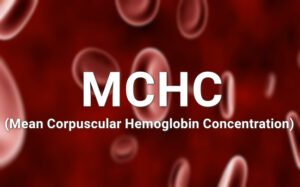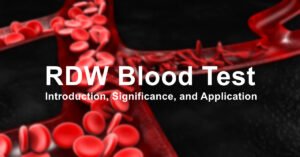A Creatine kinase (CK) blood test is a laboratory test to evaluate the amount of creatine kinase in the blood. Creatine kinase (CK) is a dimeric enzyme also called creatine phosphokinase (CPK).
Creatine phosphokinase or creatine kinase is a muscle-specific enzyme and the most sensitive indicator for muscle damage. It has a half-life of almost 2 hours(6). It’s an important enzyme that catalyzes the phosphorylation process (see below in the diagram).
What is Creatine Kinase (CK)?
Creatine kinase (CK) a type of protein known as enzyme is predominantly found in skeletal muscle and mitochondrial cytoplasm. It can also be found in the brain, cardiac muscles, and other body tissues. The main role of the Creatine kinase (CK) enzyme is in the transportation and generation of phosphate molecules.
Creatine kinase (CK) enzyme has two subunits: M and B.
M is for muscle, and B is for the brain.
Creatine kinase is a protein that is metabolized by the process of proteolysis. Proteolysis for CK occurs in lymph nodes or local tissue.
Creatine kinase (CK) enzyme catalyzes the reversible phosphorylation reaction.

ADP + creatine phosphate → ATP + creatine
Principle of CK blood test procedure
- The Creatine Kinase assay shows the quantity of creatine kinase in human plasma or serum.
- Creatine kinase (CK) enzyme will catalyze the reaction.
- The high-energy phosphate group is transferred from creatine phosphate to ADP.
- ATP is produced.
- This ATP will be used to phosphorylate glucose molecules.
- Glucose-6-phosphate will be formed in the presence of hexokinase.
Then glucose-6-phosphate dehydrogenase enzyme oxidizes Glucose-6-phosphate and reduces nicotinamide adenine dinucleotide phosphate to nicotinamide adenine dinucleotide phosphate reduced form, also called NADPH.
The formation rate of NADPH is directly proportional to the activity of the Creatine kinase (CK) enzyme in the sample. N-acetyl-L-cysteine (NAC) acts as an enzyme reactivator in all these reactions.
Isoenzymes of Creatine kinase
Creatine kinase (CK) enzyme has three isomeric forms; Creatine kinase-MM (CK-MM), Creatine kinase-MB (CK-MB), and Creatine kinase- BB (CK-BB).(5)
1. CK-BB/CK-1
- Brain tissues are the primary source of Creatine kinase- BB (CK-BB).
- It can also be found in the lungs, prostate, uterus, and thyroid.
2. CK-MB/CK-2
- CK-MB is highly concentrated in cardiac muscles.
- It is mainly found in type 1 muscle fibers.
- It is more sensitive and specific for detecting myocardial necrosis than total CK enzyme.
- Compared to total CK in skeletal muscles, 1-3% is CKMB, and in cardiac muscles, it is 15-30%(5).
- CK-MB can also be found in other structures like the prostate, intestine, uterus, and diaphragm.
3. CK-MM/CK-3
- CK-MM is an isoform of the CK enzyme highly concentrated in skeletal muscles.
- That’s why it’s used to diagnose muscular disease.
Role of CK-MB in Acute Myocardial Infarction
- CK-MB is the most sensitive and specific indicator for diagnosing acute MI.
- After 3-4 hours from the onset of myocardial injury, CK-MB level increases.
- It will reach its peak in 12-18 hours.
- It will fall to its baseline within 2-3 days.
- Because it takes a few hours to elevate, it’s needed to do serial measurements for 24 hours.
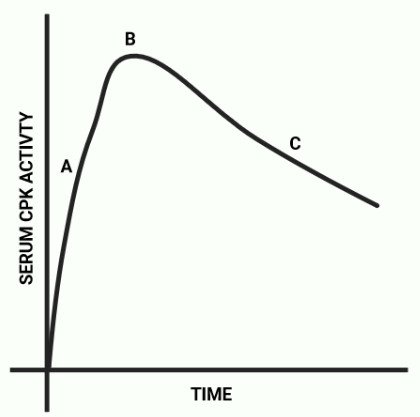
Normal Range
Normal range for creatine kinase or creatine phosphokinase is:(1)
| Adult/elderly | • Male: 55 -170 units/L (SI units) • Female: 30 -135 units/L (SI units) |
| Newborn | • 68-580 units/L (SI units) – this is approximately 2 to 3 times the adult values |
| Above 90 years | Males = 21 – 203 U/L Females = 22- 99 U/L |
Normal Range for isoenzymes of CK or CPK
| Creatine kinase-MM (CK-MM) also called CK-3 | • 94 -100% |
| Creatine kinase-MB (CK-MB) also called CK-2 | • 0 – 6 % |
| Creatine kinase- BB (CK-BB) also called CK-1 | • 0% |
Note: Creatine kinase (CK) enzyme values may be variable according to the age, race, gender, and physical activity. The value of Creatine kinase (CK) is higher in newborns and black males. There is also variation in the upper limit of creatine kinase enzymes in athletes.
| Types | Composition | Comment |
|---|---|---|
| Skeletal Muscle | 98% – CK-MM 2% – CK-MB | Elevated in muscle disease |
| Cardiac Muscle | 70-80% – CK-MM 20-30% – CK-MB | Cardiac muscle has highest amount of CK-MB |
| Brain | CK-BB | |
| Plasma | Mainly CK-MM |
Visual Representation for better understanding
Creatine kinase (CPK/CK) isoenzymes subtypes and distribution

Creatine kinase (CPK/CK) isoenzymes subtypes and (distribution in percentages)

Total Creatine kinase (CPK/CK) distribution

Collection of sample (Precautions to be taken)
- The sample is collected in heparinized tubes.
- Subject is not needed to avoid taking meals.
- We can draw the sample at any time of the day.
- It is important to collect the blood sample after or an hour before an intramuscular injection.
- Storage temperature should be between 4℃ to 24℃ for next 3 days.
Specifications of CK blood test
| Indication | CK blood test is used to evaluate: • Skeletal • Muscle • Heart • Brain |
| Type of specimen | Serum or plasma |
| Container used | Heparinized tube is preferred |
| Quantity | 0.6ml of blood should be drawn for test |
| Specimen storage (Serum and plasma) | • 20 to 25°C for two days (3) • 2 to 8°C for seven days (3, 4) |
| Precautions | • Store the sample in the proper light and temperature. • Avoid hemolyzed blood sample. • Don’t take a sample just after the IM injection. • Rule out trauma, it may make the test unreliable. • No special preparation is needed. |
Clinical Significance of Creatine kinase blood test(7)
- In case of muscular damage, creatine kinase evaluation should be suspected.
- In case of inflammation, damage, or injury to skeletal muscles, necrosis, or heart muscle damage, serum creatine kinase level is elevated.
- Level of creatine kinase elevates in neuromuscular disorders.
- Serum level of creatine kinase is increased in all types of muscular dystrophy.
- Serum creatine kinase level falls in older ages.
- Serum creatine kinase level increases almost 3 to 6 times in Duchene muscular dystrophy.
- Levels may also increase after IM (Intramuscular) injection or surgical intervention.
- Serum creatine kinase level is helpful in making a diagnosis and in the monitoring of muscular diseases like neuromuscular disorders and muscular damage.
What happens if the value of the Creatine kinase (CK) blood test is elevated?
The increased value of the Creatine kinase (CK) blood test is diagnostic for several diseases like:
- Acute myocardial infarction (MI)
- Myopathies
- Rhabdomyolysis
- Muscular dystrophy
- Malignant hyperthermia
- Neuroleptic malignant syndrome
- Paralysis (periodic)
- Drug-induced myopathies
- Renal damage
- Intramuscular injection
- Strenuous exercises
What happens if the value of the Creatine kinase (CK) blood test is below normal?
Creatine kinase value is linked with the amount of muscle in the body. Its value may be below the normal range in the following conditions:
- Lean muscle mass
- In females as compared to males
- Alcoholic liver disease
- Rheumatoid arthritis
Some are confused about the Creatine and Creatinine blood tests – here is a table of comparison between them to help you understand better
Difference between Creatine and Creatinine
| Creatine | Creatinine |
|---|---|
| The Creatine is 2-(carbamimidoyl-methyl amino) acetic acid | Creatinine is 2-amino-1-methyl-5h-imidazole-4-one |
| The creatine is a linear molecule and amino acid. | Creatinine is a heterocyclic structure and a chemical waste. |
| It is formed by protein metabolism. | It is formed by creatine metabolism. |
| It is used as a supplement to increase muscle mass. | It is a waste product of creatine metabolism. |
| It provides energy to muscles. | It is used along with BUN to determine renal function. |
| It is produced by the liver, pancreas, and kidneys and is sent to the muscles. | It is produced in the muscles by creatine breakdown. |
Frequently asked questions
Q1. How can the Creatine kinase (CK) blood test be misinterpreted?
The misinterpretation of the Creatine kinase (CK) blood test is due to the presence of 5-7% of CK-MB in skeletal muscles. CK-MB is cardiac muscle-specific but skeletal muscle injury can also elevate it. And it can be misinterpreted. (2)
Q2. What happens if the value of CK-MB is above normal?
CK-MB enzyme is primarily present in the heart muscles and is a very useful marker for diagnosing acute myocardial injury. It can also be elevated in the following conditions:
• Cardiac surgery
• Cardiac contusion
• Trauma
• Myocarditis
• Defibrillation or cardioversion
• Endomyocardial biopsy
Q3. What happens if the value of CK-BB is above normal?
The increased value of CK-BB is suggestive of Brain injury.
Q4. What happens if the value of CK-BB is below normal?
The decreased value of CK-BB is suggestive of
• Multiple sclerosis.
• Huntington’s diseases.
• Amyotrophic lateral sclerosis.
Q5. Why is the Creatine Kinase test performed?
Creatine kinase or creatine phosphokinase test is performed to evaluate the cause of chest pain, and differentiate between postoperative infection and malignant hyperthermia. It is also important to know the pattern of CK enzyme rise and fall especially when we are calculating it for myocardial infarction.
Reference
- Pagana KD, Pagana TJ, Pagana TN. Mosbey’s Diagnostic and Laboratory Test Reference. 14th ed. St. Louis, Mo: Elsevier; 2019.
- Cabaniss, C.D. Creatine Kinase. H. W. Walker HK, Hurst JW, Clinical Methods: The History, Physical, and Laboratory Examinations. Boston: Butterworths; 1990. 32.
- Guder WG, Narayanan S, Wisser H, et al. List of analytes— preanalytical variables. Annex In: Samples: From the Patient to the Laboratory. Darmstadt, Germany: GIT Verlag; 1996:Annex 12–3.
- US Pharmacopeial Convention, Inc. General notices. In: US Pharmacopeia National Formulary, 1995 ed (USP 23/NF 18). Rockville, MD: The US Pharmacopeial Convention, Inc; 1994:11.
- Cigdem Yucel, Chapter 4 – Cardiac biomarkers: definition, detection, diagnostic use, and efficiency, Editor(s): Sibel A. Ozkan, Nurgul K. Bakirhan, Fariba Mollarasouli, The Detection of Biomarkers, Academic Press, 2022, Pages 113-130, ISBN 9780128228593, https://doi.org/10.1016/B978-0-12-822859-3.00007-9
- Janene K. Kingston, Chapter 7.1 – Hematologic and serum biochemical responses to exercise and training, Editor(s): Kenneth W. Hinchcliff, Raymond J. Geor, Andris J. Kaneps, Equine Exercise Physiology, W.B. Saunders, 2008, Pages 398-409, ISBN 9780702028571, https://doi.org/10.1016/B978-070202857-1.50019-6.
- Tietz Textbook of Clinical Chemistry and Molecular Diagnostics – 6th Edition. (2017, January 16). Retrieved October 21, 2022, from https://www.elsevier.com/books/tietz-textbook-of-clinical-chemistry-and-molecular-diagnostics/rifai/978-0-323-35921-4

